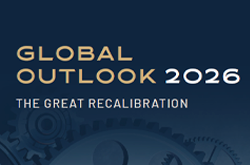A transforming world
Download the Indosuez 2025 Global Outlook here
In our previous Global Outlook edition, titled “Searching for a new inflation regime,” we empha-sised “the need to move away from high inflation, avoid stagflation, and reach a reflation regime”. Have we achieved this? Headline inflation in the United States has decreased from 3.4% to 2.4%, and in the Euro Area, it has dropped from 2.9% to the European Central Bank’s (ECB) target of 2.0%. This progress has allowed seven of the ten major developed-market central banks to begin cutting interest rates, with the ECB initiating cuts three months before the Federal Reserve (Fed) in June. Both governing councils are now embark-ing on monetary policy normalisation. Is it mission accomplished for 2025?
CRUISING ALTITUDE
Throughout 2024, we maintained a soft landing scenario for the US economy, despite facing an inflation scare in Q1 2024 followed by a recession scare during summer. We held firm to our view, and we believe this situation will likely persist into 2025. We expect the US economy to grow by 2%, slightly above potential, while inflation should average around 2.2%. In fact, the soft landing narrative is somewhat obsolete: the US economy never really landed and continues to operate at cruising altitude. The key question for 2025 will be whether the new Trump administration will be reflationary or stagflationary.
FROM POLITICAL TO POLICY UNCERTAINTIES
In 2024, 40% of the world’s population was expected to vote. Elections in India and the European Union (EU) brought surprises, while the US election outcome was clear and uncontested but opened the door to many questions. We are transitioning from an era of political uncertainties in 2024 to an era of policy uncertainties in 2025.
The new Trump administration is widely seen as pro-growth, pro-business, and pro-deregulation, likely to extend tax cuts and reduce corporate taxes. With the US economy already on a positive trajectory, these reflationary policies could push the economy into overheating. In this no landing scenario, the Fed might be forced to halt its rate cut cycle prematurely, posing a risk to stocks and their rich valuations. It will be a delicate balance to maintain.
BATTLE OF THE GIANTS
Another policy uncertainty lies in US tariff policy. It is unclear whether the Trump administration will pursue the proposed 10%-20% blanket tariff and 60% tariff on China. More modest tariffs, similar to those seen in 2018/2019, are likely as Donald Trump seeks to bring “trophy deals” back home. While the market may worry about announcements and executive orders, our guess is that Donald Trump will avoid creating a new inflation spike, focusing instead on making trade deals. Donald Trump was elected because the rise in prices under the Biden administration proved fatal, and he will aim to avoid repeating that mistake.
The other battle could be with the Fed. We anticipate the Fed will cut rates to reach 3.5% in 2025, though there is a risk they may do less if they perceive inflation threats from tariffs. However, if tariffs remains a one off effect and inflation expectations stay anchored, the Fed might look through short-term effects and continue its policy adjustments. Jerome Powell has clearly stated, “we do not guess, we do not speculate, and we do not assume” in reference to Donald Trump’s future economic policies.
Ultimately, we believe the bond market will be the arbitrator of which policies are acceptable. While the S&P 500 will be the barometer of Donald Trump’s economic achievement, the 10-year Treasury borrowing rate will gauge his financial viability.
With US debt potentially reaching 160% of gross domestic product (GDP) by 2035 under a worst-case scenario, the Senate will be keen to avoid an out-of-control interest bill, requiring more careful public finance.
WHATEVER IT TAKES
What about Europe, caught between these two giants, the US and China? We expect the Euro Area economy to record subpotential growth at 0.8% in 2025, with downside risks. The ECB, well aware of the economy’s weaknesses, is ready to act. We forecast additional cuts to reach 2% in 2025 but note this is skewed to the downside to counter-act any further weakness from tariffs and its economic impact.
A second Trump administration could be a decisive and transformative moment for Europe, particularly concerning its own defence. As the French President stated after Donald Trump’s victory, “Do we want to read the history written by others?” In other words, Europe needs to write its own history in protecting its own interests. The sudden break-up of the German coalition reopens the debate around the constitutional debt brake1. With the German deficit at 63% of GDP, there is considerable room for Germany to stimulate investments, both for its own sake and in embracing joint debt efforts for European defence. This could become the “Whatever it takes” moment for protecting Europe, though it will likely take time and may not be a short-term catalyst for changing investor perception of Europe.
This new edition, “A Transforming World”, explores the evolving macroeconomic landscape, including AI’s impact on growth, setting equilibrium interest rates, shifts away from the US dollar in currency markets, China’s economic rebalancing, and the energy transition towards electrification. We examine these captivating themes to provide valuable insights.
On a final note, it is also a transforming world for Indosuez Wealth Management, following the acquisition of Degroof Petercam. We welcome two new contributors in this edition: Jérôme van der Bruggen, who shares our key messages, and Hans Bevers, who provides a fascinating article about setting the neutral central bank policy rate, “A long-term macroeconomic story: written in R-star.”
December 09, 2024


